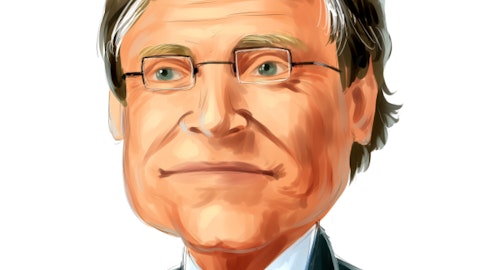Another thing that we did is that we improved and increased weekend pickups in several key markets during the year. So and I could go on and on and on, but this is a way of operationalizing excellence to drive the business and capture share. So where are we going to capture share? We’re going to continue to lean into the small and medium-sized segment opportunities, we’re seeing some real success in that area. We’re going to continue to lean into healthcare. When I started here, the healthcare revenues are around $6 billion, now at $10 billion, and we’re going to continue to grow. We’ll lay out our three-year growth plans for you at our March Investor Day. I think you’ll be very pleased with that. We’re going to continue to sell off the service that we provide and the capabilities that we have that actually no one else has, that’s our integrated network.
So at our Investor Day in March, we’ll lay out market share capture. Let me just make the market real for you because this might be helpful too. As we think about the addressable market, the addressable market in the United States. It’s a little over 52 million packages a day. So there’s plenty of addressable market for us to go get. And plenty of market for us to get outside of the United States because we are underpenetrated in so many areas. One reason I called out our new air hub in the Hong Kong International Airport is that the greater China Bay area is unbelievable economic power base, the 13th largest economy in the world, 37% of all China exports go through that airport. And today, we have small way overcapacity hubs and buildings that are inefficient with lease rates that are sky high.
So we are building a 20,000 square meter facility. It will make us the second largest air hub in that important part of the market. So expect to see a lot of growth coming off of that over time.
Allison Poliniak: Great. Thank you.
Operator: Our next question will come from the line of Tom Wadewitz of UBS. Please go ahead.
Tom Wadewitz: Yeah, good morning. So I wanted to see if you could talk a little bit about the competitive dynamic in the market. I know the backdrop is that you had some share loss associated with the Teamster contract, but it also seems like there might be risks that other competitors are gaining traction in the market. So if you look at postal service had, I think, up 7% volumes and they had a new product, the ground advantage. And so I guess the question is, is there a risk that the competitive set has got more challenging? And how do we think about what you need to do to have a better volume outcome in 2024? Is there more pressure on price, or is it a different formula to get the better volume outcome in ’24? Thank you.
Carol Tome: So I would say that the pricing environment is very rational. And you can see that as Brian ticked out the RPP performance in the fourth quarter, we had very strong base rate performance. Now the RPP was muted because of lower fuel costs and product characteristics and the product mix change and lower demand surcharges, but the base was very strong. And we expect the base to continue into 2024, our GRI for 2024 is 5.9%. Will we keep all of it? No. But will we keep a lot of it? Yes, just like we did in 2023, we kept about 60% of the GRI in 2023. So the pricing environment is rational. In terms of competitive products, it’s incumbent upon us to stay at leading edge and meeting our customers where they want us to be.
That’s one reason we offered a hyper-local product beginning last quarter, which is really a short-zone product. We haven’t had that before. And as we look at the offerings that we will go to market with this year, we’ve got some things underway, not ready for prime time, but I suspect looking over at our new Chief Commercial Officer, Matt Guffey, that we might be able to talk about that at our March investor conference and he’s nodding his head. So stay tuned for that.
Tom Wadewitz: Okay. Thank you.
Operator: Our next question will come from the line of Jeff Kauffman of Vertical Research Partners. Please go ahead.
Jeff Kauffman: Thank you very much. I’m going to defer the big picture stuff to March. But I’m just kind of curious, how did your global view changed between when we were discussing the labor deal back in August, September to the year-end? You mentioned the softness in Europe. You mentioned the shift from air to ground, but kind of what were the big changes in your outlook over that four, five-month period?
Carol Tome: Well, what really softened up was Europe. If you look at our volume decline, both domestic and export, it was heavily weighted in Europe. In fact, the decline in our export was 94%, driven by the softness in Europe. So you see what’s happening with industrial manufacturing there is just way off. So that is a big change. There are also dynamics happening in air and ocean freight as you’ve been watching. We’ve all been watching the drama in the Red Sea, the fact that the water levels in the Panama Canal are low, and that certainly is causing a lot of chaos actually in ocean and air freights. Interestingly, on the air side, both rates and volumes were down. On the ocean side, volumes are up. But as Brian called out, the rates were considerably down.





